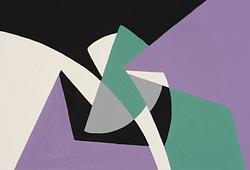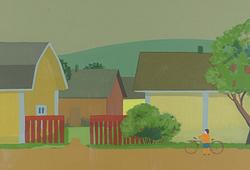Modern Art & Design Presents Carl Kylberg
Bukowskis presents the work "Morgon i hamn" by Carl Kylberg at this autumn's live auction, Modern Art & Design – The leading live auction for modern art and design in the Nordics.
Carl Kylberg’s seascapes are dreamlike and enigmatic. He conveys the beauty of sunsets, ships on the horizon, calm waters, and a deep sense of tranquillity. As a teenager, Carl Kylberg signed on to the training ship Abraham Rydberg, inspired by his older brother Fredrik, a sailor who had already travelled on the same vessel. The experiences he gained during this relatively brief period would later inspire one of his most celebrated works, “Den flygande holländaren” (The Flying Dutchman), along with several other mysterious ships depicted in atmospheres of shimmering light and strange twilight. Kylberg often spoke of his existential encounter with the infinite sea and the solitary ship when he was about to embark on Abraham Rydberg, moored off Sandhamn. He arrived at dusk and saw the ship lying on the mirror-like water in the fading light of summer — a vision, almost dreamlike, that would stay with him for life.
“These colours burn so fiercely in the painter’s imagination that they consume form and content, reason and meaning,” wrote Ragnar Josephson in his review of Kylberg’s first solo exhibition in 1926. Kylberg’s love of colour was profound. The colours, he said, existed within him, and through them he could express his emotions. He had a particular fondness for red, green, yellow, blue, and orange. He often returned to certain motifs such as “Meditation” and “Flygande holländaren” (The Flying Dutchman). The subject “Morgon i hamn” (Morning in the Harbour) also appears in three variations.

Kylberg sought in his painting to express the spiritual, the universal, and the human. In his diaries, he continuously commented on his painting, and there one can find the key that illuminates his deeply thoughtful artistry. In his scenography were the ideas of human destiny as a journey — the ship approaching land with the fates of humankind on board, or setting out across the vast open sea to meet an unexpected fate.
Kylberg is difficult to place within any specific artistic “-ism.” Vincent van Gogh had a significant influence on Kylberg’s art through his liberating technique. To some extent, Kylberg’s works can be compared with those of William Turner, since both naturally unite man and nature. A common denominator between Turner and Kylberg is the sun. It forms an obvious part of reality, and through its many color variations it also becomes an entryway to something deeper and more abstract.
The painting "Morgon i hamn" is characteristic of Kylberg’s mature style, with a stronger expression and more intense colors. The character of the motif is typical of Kylberg, and many of his seascapes were created during summer stays in Danish Ålsgårde in 1936–37. Kylberg believed that color was fundamental to genuine and meaningful painting. He built his images through color, but did not see himself as an expressionist. He distanced himself from the expressionists’ brutal colors and grotesque exaggerations. Instead, he used the external world and the landscape as means to reach deeper emotions and to communicate with the viewer. As he put it: “The essence of painting is nothing other than expressing what is seen in the soul, not painting houses and superficial events…”
The composition of "Morgon i hamn" is constructed from horizontal bands of color. The foreground consists of a strip of land that merges with the sunlit sea. In the mirror-like bay lies a sailing ship, which Brita Knyphausen interprets as a symbol of both journey and longing. The sailing ship lies at anchor, yet could depart at any moment, as the sea stretches beyond the frame.
Knyphausen quotes Kylberg: “[...] a painting should only be a gateway [...] This gateway must be such that it draws and invites further searching.”To achieve this, Kylberg used technical methods such as aerial perspective and broad brushstrokes, where some color fields hover in front of others, creating a sense of depth. In this contemplative motif, which carries an almost sacred feeling—with the sea as a link between earth and sky—we may be tempted to see Kylberg as an escapist. For him, the painterly process was about leading us into a dream world. Kylberg wanted to give the viewer the tools to see beyond the familiar and to activate us in our encounter with the image. “I cannot waste precious time convincing people of what they already know [...] I want to convince people that the eyes of their soul can also see.” — Carl Kylberg
To the catalogue
The work will be sold at Modern Art & Design
Estimate 1 200 000 - 1 500 000 SEK
Catalogue online November 4
Viewing November 12–17, Berzelii Park 1, Stockholm
Live auction November 18–19, Arsenalsgatan 2, Stockholm
Read more about Modern Art & Design
All works by Carl Kylberg at Modern Art & Design
Requests & condition reports

Stockholm
Louise Wrede
Head of Art Department, Specialist Contemporary Art, Private Sales
+46 (0)739 40 08 19
































